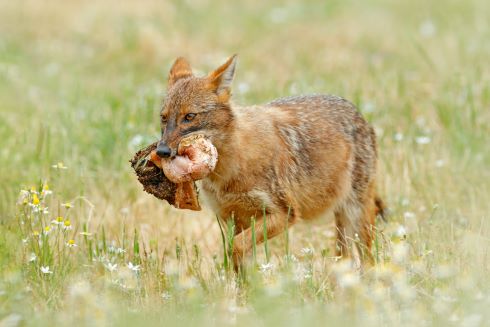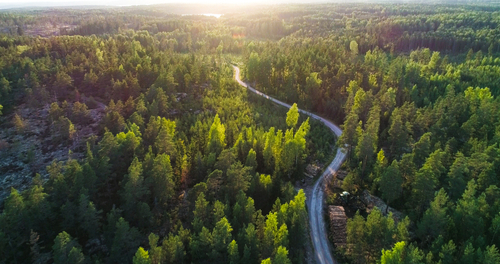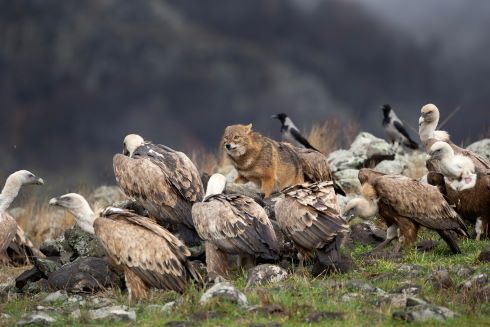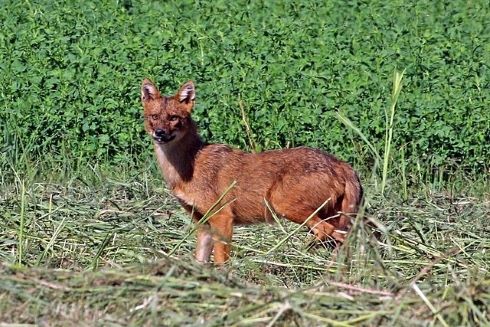The way of the jackal

The arrival of the golden jackal in northern Europe has raised interesting questions about how we define and respond to ‘invasive’ species in rapidly warming parts of the world, writes Sam Perrin
20th February 2023
In July 2019, as summer reached its zenith in a part of the world that relishes any sunlight it can get, a dog-like creature made headlines after being spotted in Southern Finland. It looked like a strange mix between a wolf and a fox, but was clearly neither. It was not native to Finland, but was definitely not one of the invasive escapees brought to Northern Europe for its fur, such as the raccoon dog.
It turned out to be a golden jackal (Canis aureus), a species more closely related to the African or Ethiopian wolf than your standard European variety. It was the first glimpse of a species that has crept further northward ever since, making headlines whenever it pops up in a new area. Norway reported seeing a golden jackal toward the end of 2021, and sub-Arctic Russia deemed its first jackal sighting newsworthy in the summer of 2022.
Reports of a new species can often be greeted with trepidation, and for good reason. Invasive species – non-native species that cause harm to local ecosystems – are the second-biggest threat to biodiversity worldwide. The Nordic countries (Norway, Sweden and Finland) are all too familiar with invasives and all have had bad experiences with new mammals. The aforementioned raccoon dogs, raccoons and even American minks have wreaked havoc upon bird and small mammal populations in the area.
Yet classifying a species as invasive – or even non-native – is not a decision made lightly in this part of the world. Such terms are dichotomous – a species is either invasive or it isn’t; non-native or native. Instead, species are often depicted on more of a risk spectrum depending on their capacity to spread easily and the actual harm they’re predicted to have on the local ecosystem.
As such, a species that spreads easily but doesn’t meaningfully impact local species might be low risk, as would an extremely harmful species that doesn’t readily move from place to place. That risk category is assigned, and the species is placed on the local non-native list – or, in the case of the Nordic countries, the alien species list.
 In the past decade the golden jackal's range has expanded into the sub-Arctic regions including Finland (pictured), Russia, and Norway.
In the past decade the golden jackal's range has expanded into the sub-Arctic regions including Finland (pictured), Russia, and Norway. Alien or not?
When the golden jackal appeared most onlookers assumed it was just a matter of time before the species was duly assigned a classification by local authorities. Yet first Finland then Norway announced that the species wouldn’t make it on to the list.
“We have a very clear prerequisite for a species to be considered ‘alien’,” explains Dr Olga Hilmo, senior adviser at Norwegian institute Artsdatabanken, which handles the Norwegian iteration of the alien species list. “It needs to come here assisted by humans. The jackal has made it here by itself, so to us it’s not alien.”
It might seem a stretch for a species that was in Rudyard Kipling’s Law of the Jungle and calls India its home to make it to the Arctic circle unassisted. Yet the jackal’s native range stretches through the Persian Gulf and well into Europe, with the population having spread north from Bulgaria and Romania since its resurgence in the late 1950s. With the Arctic and sub-Arctic warming at much faster rates than the rest of the planet, it’s not surprising that a species could make its way up into that part of the world given time.
Moving through a warming world
That poses an interesting question. Climate change could see the Arctic warm at three times the global rate in the coming decades, with the sub-Arctic not far behind it. That will gradually mean the entire area will fall very much into the comfortable temperature range for a barrage of new species. “Climate change is man-made, there’s no doubt about it. But we don’t consider it a direct effect of humans on the species,” says Dr Tanja Kofod Petersen, who manages the alien species list with Hilmo.
It’s a tricky aspect of the ‘alien’ definition, and one that is becoming more and more pressing. Climate-change-driven ‘range-shifters’ might be moving at a faster rate in the rapidly warming Arctic, but they’re popping up worldwide, especially in our oceans where barriers for dispersal aren’t as prevalent.
These aren’t sudden, immediate changes, explains Gretta Pecl, professor of marine socioecology at the University of Tasmania. “These species aren’t changing the conditions that they like; they’re just shifting to stay in the environment that they’re comfortable in. It’s the kind of thing we’d normally see over thousands of years, but we’re seeing it happen over tens of years. It’s literally a global redistribution of life on Earth.”

Climate change isn’t the only indirect factor enabling new species to spread. Human constructs are also allowing species to move into new areas. The construction of the Suez Canal in the mid 1800s allowed new species to move from the Red Sea into the Mediterranean. Among these were species of rabbitfish, which set about transforming Mediterranean ecosystems and were subsequently named an invasive species. The rabbitfishes fall into a category that professor of biosecurity Philip Hulme named a ‘corridor species’ – one that makes its way into new regions with the help of human land-use change.
This poses another interesting question – climate change may not be considered a direct enough effect upon a species, but what about sweeping changes to the landscape? It’s still unclear as to whether anthropogenic changes such as the destruction of forests, construction of roads and reduction of wolf populations have enabled the golden jackal to spread. But if they did, would our effect on Europe’s landscape become enough of a direct impact to classify a species moving through it as alien?
“No, that would not change our stance,” maintains Petersen. “We do classify corridor species as alien, but for us to consider the jackal a corridor species, it would have to have travelled here exclusively via man-made roads. It is not enough that landscape changes make it easier.”
Ultimately, the golden jackal will not find its way on to the alien species list, continues Petersen. “The fact is that if we put it on there, then we set a precedent whereby every other range-shifter has to go on there as well.”
 The golden jackal, pictured in Greece. Image courtesy of Charles J Sharp via Wikimedia Commons.
The golden jackal, pictured in Greece. Image courtesy of Charles J Sharp via Wikimedia Commons. Carnivore controversy
Yet simply not being a non-native or alien species does nothing to guarantee the jackal free passage throughout a country. Initial reactions to the jackal’s first sightings in both Finland and Norway were aggressive, with calls both from social media and government officials for the individuals to be shot immediately. Northern Europe already has a long-standing and complex relationship with carnivores.
Wolves, bears and other large mammals were pushed out of the area centuries ago, and have only been making their way back into parts of the region in recent decades, often to much controversy.
“If we had an individual coming into Sweden, I would not be surprised if the Environmental Protection Agency just decided to remove it,” speculates Fredrik Widemo, associate professor in wildlife-forest interactions at the Swedish University of Agricultural Sciences.
“The jackals are capable of taking down lambs, as well as plenty of native ground-nesting birds. Whether they’re alien or not, they’re going to affect our local species.”
Native carnivores already face high levels of persecution from Nordic farmers. Livestock are left to roam here freely for large parts of the year without supervision from humans or dogs, or even protection from fences. Grouse and capercaillie, also potential prey for golden jackals, are native, cultural icons and popular hunting targets.
Nordic farmers are quick to call for culls of wolves, which are regularly carried out, regardless of the wolf’s native status. It’s often argued that the attitude to wolves represents a more rural perspective in this part of the world, with urban populations being more tolerant of the predators. Yet the quick, decisive euthanasia of a fox in Oslo that attacked several dogs in summer 2021 suggests that the stance on predators is not as simple as a rural/urban divide.
“I don’t think we should let the golden jackal establish in Sweden,” insists Widemo. “Knowing the level of predation on ground-nesting birds we have here, I would not want another predator like the raccoon dog. It’s absurd that we should accept the one and not the other just because one walked here on its own account.”
Crossing borders
That brings us to the final issue in this see-sawing series of questions. Let’s say there was a sudden change of policy, and the jackals found themselves on the wrong side of both Artsdatabanken, hunters and farmers. Is there any point in keeping out a species that can clearly make its way into a new ecosystem under its own steam? The golden jackal is not currently being treated as a threat or actively exterminated anywhere immediately south of the Nordic countries. As such, it will likely continue to trickle over the border.
Should we maintain ecosystems in a certain state when the world around them is changing? It’s a concept that Professor Mark Davis at Macalester College refers to as a ‘habitat museum’.
“People like to go to museums, see historical towns and experience things the way they used to be. The idea of maintaining a lake or grassland so that it’s the same as it was 50, or even 150, years ago compared with now would be interesting, but it’s essentially the same as a museum – you’re creating time pockets.”
It’s clear both the scientific and non-scientific communities are still coming to terms with a global redistribution of life. Much of it is small – plankton drifting further north or south, birds moving their migration routes by a few kilometres every year – but every now and then a species arrives in a part of the world where the impact will be significant. The best way to respond remains up for discussion.
I’ll be watching with interest to see how the newspaper headlines change for the jackal.
Dr Sam Wenaas Perrin is an invasion ecologist and climate data analyst and founder/editor of the blog Ecology for the Masses.


